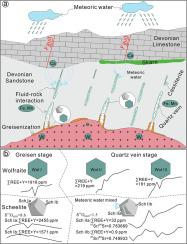Ore Geology Reviews ( IF 3.2 ) Pub Date : 2022-08-18 , DOI: 10.1016/j.oregeorev.2022.105066 Hua Jiang , Biao Liu , Hua Kong , Qian-hong Wu , Shefa Chen , Huan Li , Jing-hua Wu

|
Wolframite and scheelite are primary W–bearing minerals and form in multiple metallogenic stages in quartz-vein type W(–Sn) deposits, recording copious metallogenic information. This study investigates the geochemistry, geochronology and Sr–O isotope of these minerals in the Yaogangxian W(–Sn) deposit, South China, to constrain the metallogenic age and decipher the mineralization process. Three wolframite and scheelite phases were identified in the greisen and quartz-vein type ores with different cathodoluminescence (CL) response, rare-earth element (REE) characteristics, and Sr–O isotopic compositions. The Cassiterite U–Pb dating in the greisen phase yielded a 156.0 ± 0.7 Ma isochron age and a 147.5 ± 0.6 Ma isochron age in the oxide phase, both of which are within error or slightly younger than Jurassic granites. From the early to late stage, the ΣREE contents of scheelite and wolframite decreased sharply, and the REE patterns of the scheelite changed from the LREE-enriched with negative Eu anomalies to HREE-enriched with positive Eu anomalies. The δ18OH2O values of the fluid (8.5 ‰–8.8 ‰) in the greisen phase calculated using the scheelite–H2O fractionation equation are identical to the magmatic–hydrothermal fluid, whereas the δ18OH2O values of the fluid (1.4 ‰–1.6 ‰) in the sulfide phase indicate the fluid mixing with meteoric water. The (87Sr/86Sr)0 ratios of wolframite and scheelite in the quartz-vein type ores range from the 0.74972 to 0.78397, higher than the Jurassic granites ((87Sr/86Sr)0 = 0.71593–0.73188) but lower than the sandstone in the host rock ((87Sr/86Sr)0 = 0.785227–0.813912), indicating an intense fluid-rock interaction. Therefore, although the W(–Sn) mineralization is primarily related to Jurassic granites, fluid mixing and fluid–rock interaction in the quartz-vein type ores might have been a trigger mechanism for W(–Sn) precipitation.
中文翻译:

华南姚岗县石英脉型W(-Sn)矿床黑钨矿和白钨矿的原位地球化学及Sr-O同位素组成
黑钨矿和白钨矿是主要的含 W 矿物,在石英脉型 W(-Sn) 矿床的多个成矿阶段形成,记录了丰富的成矿信息。本研究对华南瑶岗县W(-Sn)矿床中这些矿物的地球化学、年代学和Sr-O同位素进行了调查,以限定成矿年龄并破译成矿过程。在具有不同阴极发光 (CL) 响应、稀土元素 (REE) 特征和 Sr-O 同位素组成的灰色和石英脉型矿石中鉴定出三种黑钨矿和白钨矿相。greisen 期锡石 U-Pb 测年的等时线年龄为 156.0 ± 0.7 Ma,氧化期等时线年龄为 147.5 ± 0.6 Ma,两者均在误差范围内或比侏罗纪花岗岩略年轻。从早期到晚期,白钨矿和黑钨矿的ΣREE含量急剧下降,白钨矿的REE模式从富含LREE的负Eu异常转变为富含HREE的正Eu异常。δ用白钨矿-H 2 O分馏方程计算的灰相流体18 O H2O值(8.5 ‰~8.8 ‰)与岩浆-热液流体相同,而流体的δ 18 O H2O值(1.4 ‰) –1.6 ‰) 硫化物相表示与大气水混合的流体。石英脉型矿石中黑钨矿与白钨矿的( 87 Sr/ 86 Sr) 0比值在0.74972~0.78397之间,高于侏罗系花岗岩(( 87 Sr/ 86 Sr) 0 = 0.71593~0.73188),但低于母岩中的砂岩 (( 87 Sr/ 86Sr) 0 = 0.785227–0.813912),表明强烈的流体-岩石相互作用。因此,尽管 W(-Sn) 矿化主要与侏罗纪花岗岩有关,但石英脉型矿石中的流体混合和流体-岩石相互作用可能是 W(-Sn) 沉淀的触发机制。











































 京公网安备 11010802027423号
京公网安备 11010802027423号